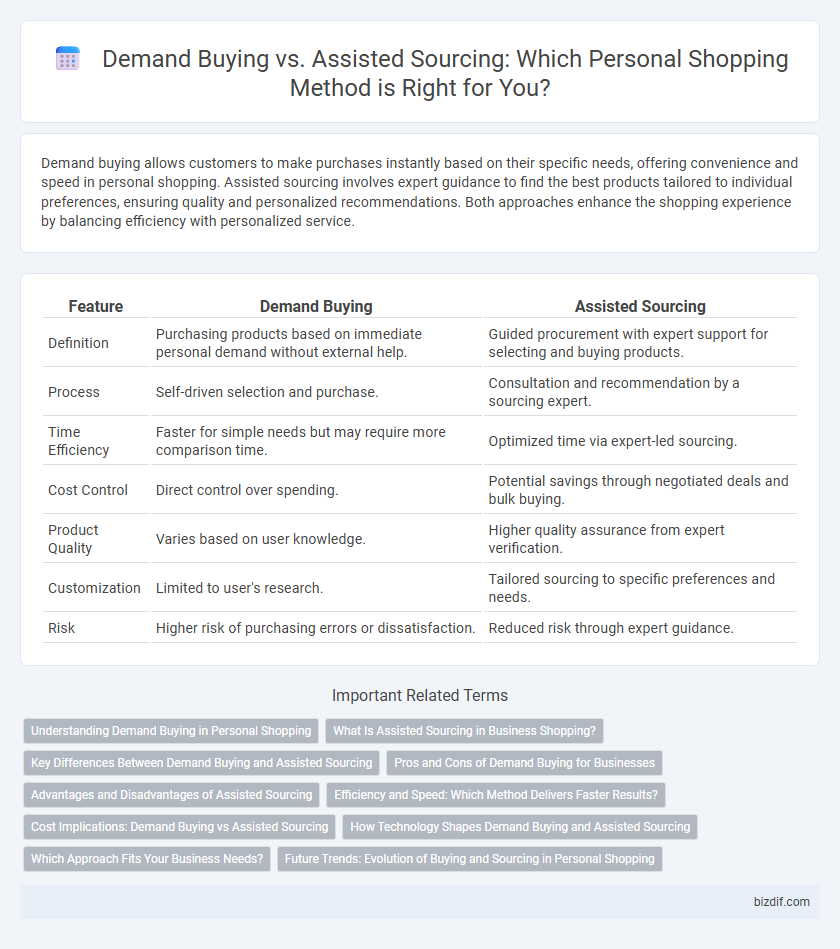Demand buying allows customers to make purchases instantly based on their specific needs, offering convenience and speed in personal shopping. Assisted sourcing involves expert guidance to find the best products tailored to individual preferences, ensuring quality and personalized recommendations. Both approaches enhance the shopping experience by balancing efficiency with personalized service.
Table of Comparison
| Feature | Demand Buying | Assisted Sourcing |
|---|---|---|
| Definition | Purchasing products based on immediate personal demand without external help. | Guided procurement with expert support for selecting and buying products. |
| Process | Self-driven selection and purchase. | Consultation and recommendation by a sourcing expert. |
| Time Efficiency | Faster for simple needs but may require more comparison time. | Optimized time via expert-led sourcing. |
| Cost Control | Direct control over spending. | Potential savings through negotiated deals and bulk buying. |
| Product Quality | Varies based on user knowledge. | Higher quality assurance from expert verification. |
| Customization | Limited to user's research. | Tailored sourcing to specific preferences and needs. |
| Risk | Higher risk of purchasing errors or dissatisfaction. | Reduced risk through expert guidance. |
Understanding Demand Buying in Personal Shopping
Demand buying in personal shopping centers on consumers proactively selecting products based on specific needs and preferences, ensuring tailored purchases that match individual lifestyles. This approach prioritizes immediate consumption desires and personalized choices rather than relying on external recommendations or sourcing. Understanding demand buying enables shoppers to optimize their spending by focusing on desired products, enhancing the efficiency of personal shopping experiences.
What Is Assisted Sourcing in Business Shopping?
Assisted sourcing in business shopping refers to a procurement process where buyers collaborate with specialized experts or sourcing agents to identify, evaluate, and purchase products or services tailored to their specific needs. This approach streamlines complex purchasing decisions by leveraging professional market knowledge, supplier networks, and negotiation skills, ensuring optimal quality and cost-efficiency. Unlike demand buying, which relies on immediate needs and quick acquisitions, assisted sourcing emphasizes strategic planning and long-term supplier relationships.
Key Differences Between Demand Buying and Assisted Sourcing
Demand buying empowers shoppers to independently purchase products based on immediate needs, emphasizing speed and convenience, while assisted sourcing involves expert guidance to identify, evaluate, and procure items tailored to specific requirements, often used for complex or bulk orders. Demand buying relies heavily on user-driven searches and choices, contrasting with assisted sourcing's collaborative approach that leverages supplier networks and negotiation skills. The key difference lies in autonomy versus expert intervention, affecting cost efficiency, customization, and overall buyer experience.
Pros and Cons of Demand Buying for Businesses
Demand buying offers businesses immediate access to products based on real-time needs, reducing inventory costs and minimizing waste. However, reliance on demand buying can lead to higher per-unit costs and potential supply chain disruptions due to lack of bulk purchasing. Companies must weigh the flexibility and responsiveness benefits against the risk of increased expenses and inconsistent product availability.
Advantages and Disadvantages of Assisted Sourcing
Assisted sourcing in personal shopping offers the advantage of expert guidance, ensuring tailored product selection that meets specific needs and preferences. It can save time and reduce decision fatigue by leveraging professional insights and access to exclusive deals, but may involve higher costs due to service fees and less control over the buying process. Customers seeking personalized support benefit from improved satisfaction and curated options, while those prioritizing autonomy might find assisted sourcing less flexible.
Efficiency and Speed: Which Method Delivers Faster Results?
Demand buying prioritizes immediate procurement based on specific needs, enabling faster acquisition by eliminating extensive supplier research, which enhances overall efficiency. Assisted sourcing involves a collaborative process with expert support to identify optimal suppliers, potentially extending timelines but improving quality and precision. For rapid results, demand buying typically offers greater speed, while assisted sourcing balances efficiency with strategic purchasing decisions.
Cost Implications: Demand Buying vs Assisted Sourcing
Demand buying often results in higher expenses due to impulsive purchases and lack of vendor negotiation, increasing overall costs for personal shoppers. Assisted sourcing involves strategic planning and expert negotiation, reducing costs by securing better deals and avoiding unnecessary purchases. The cost implications favor assisted sourcing as a more budget-conscious approach for personalized shopping needs.
How Technology Shapes Demand Buying and Assisted Sourcing
Technology transforms demand buying by enabling real-time data analytics and customer preference tracking, allowing personalized product recommendations and inventory optimization. In assisted sourcing, digital platforms and AI-driven tools streamline supplier identification, contract management, and order processing, enhancing efficiency and accuracy. Both approaches benefit from integrated software solutions that facilitate seamless communication between buyers and sellers, reducing lead times and costs.
Which Approach Fits Your Business Needs?
Demand buying focuses on immediate purchase needs, ideal for businesses requiring quick access to specific products with minimal lead time. Assisted sourcing offers a tailored, consultative approach, best suited for companies seeking customized solutions, bulk procurement, or access to specialized suppliers. Evaluating your business's urgency, product complexity, and volume requirements will determine whether demand buying or assisted sourcing aligns better with your operational goals.
Future Trends: Evolution of Buying and Sourcing in Personal Shopping
Demand buying in personal shopping emphasizes instant access to desired products through AI-driven platforms that predict consumer preferences, while assisted sourcing leverages expert curators to personalize selections based on evolving trends. Future trends indicate a fusion of these models, with enhanced machine learning algorithms enabling hyper-personalized recommendations alongside human expertise for optimal product discovery. Integration of augmented reality and blockchain technology is expected to further transform transparency, authenticity, and seamless purchasing experiences in personal shopping.
Demand buying vs Assisted sourcing Infographic

 bizdif.com
bizdif.com